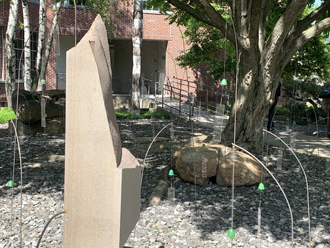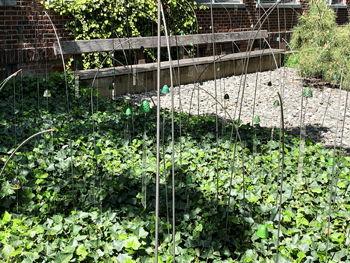Art Essay: Christian Boltanski's at Noguchi Museum May 5 - Sept 5, 2021
By Suzaan Boettger
arttimesjournal August 28, 2021
 Christian Boltanski Bells at Noguchi Museum Christian Boltanski Bells at Noguchi Museum |
Tinkle tinkle little bell – for whom do Christian Boltanski’s bells toll?
You. Me. And everyone who craves a serene escape, calling us to the verdant
sculpture garden of the Noguchi Museum, now strewn with tinkling bells. The
French artist has installed 180 slender steel rods at various heights.
Arcing over at the top, each dangles a bronze bell, and each clapper
suspends a slim rectangle of glass. Twirling in the breeze, the panes catch
the light, reflecting sparkles around ground and greens. The delicate light
and sound show envelopes and sweeps us away.
Titled Animitas, the environment takes its name from its larger version
installed in Chile’s harshly arid Atacama Desert in 2014. An animita is a
small roadside shrine honoring the departed; each chime calls up a lost
soul. There, in the desert, Boltanski positioned the 800 bells in the
locations of stars on the night of his birth, September 6, 1944,
reiterating his personal attachment to loss. Astrologically, he’s a Virgo,
a zodiac sign said to be devoted to details and also especially capable of
making the best of negative circumstances. That he has done. Born in Paris
shortly after its liberation from the Nazis (from whom his Jewish father
hid beneath floorboards), Boltanski seems to have identified not with
emancipation and relief but anticipation of a threat – a sense of the world
as a place with a strong presence of death and degradation.
 Christian Boltanski Bells at Noguchi Museum Christian Boltanski Bells at Noguchi Museum |
Boltanski’s career has been a series of environmental assemblages as
inventive as they are melancholy. Mortality is his beat; his investigations
first gained attention in the 1980s for his claustrophobic arrays of
enlarged, blurred, and roughed pictures taken from the yearbook of a prewar
private Jewish high school in Vienna whose students were likely lost during
the Holocaust. Bare light bulbs, sometimes fronting the portraits as if
under interrogation, and exposed electric cords extended the funky
materiality. Subsequently, he titled multiple stacks of worn tin boxes
“reliquaries” as if sacred containers for bits of hair, clothes, or
treasured possessions of martyrs. At his “No Man’s Land” filling the Park
Avenue Armory in 2010, piles of discarded used clothing signaled either the
disappearance of their wearers or the imminent appearance of a
catastrophe’s victims to claim these garments. Like the Romantics’ ruins,
Boltanski’s degraded compilations are both visually stirring and in
grappling with loss, aid viewers in doing so.
Boltanski’s current work still honors the dead, but the mood is not
melancholy but poignantly charming. Inside the museum, the single
stationary camera of Boltanski’s wall size video “La Forêt des Murmures,”
2016, captures the gentle effects of chiming bells and glinting glass
permanently installed on the Japanese island of Teshima. Take in as much of
the 12 hr, 52 minute recording that your meditation, muscles, or the museum
hours will allow, its darkness is a poetic simulacra inverting the direct
experience of the soothing sunlit resonance outside.
Beneath the broad canopy of the huge katsura tree, native of Japan and
grown from Noguchi’s planting in the mid-1980s, around his abstract stone
sculptures and natural boulders, Boltanski’s Animitas animates. Bells are
ringing, this timely installation calls us to tranquility – and to
remembrance of souls lost.
